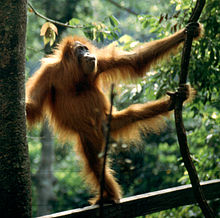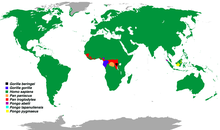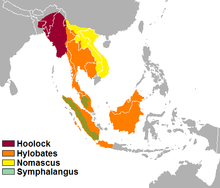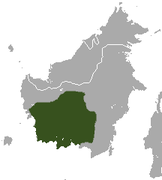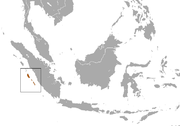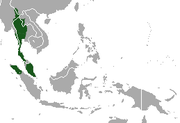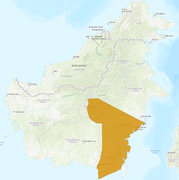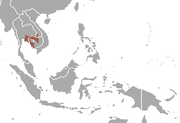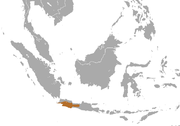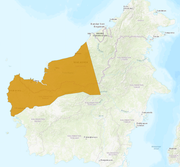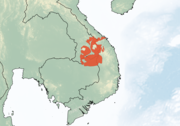J u m p t o c o n t e n t
M a i n m e n u
M a i n m e n u
N a v i g a t i o n
● M a i n p a g e ● C o n t e n t s ● C u r r e n t e v e n t s ● R a n d o m a r t i c l e ● A b o u t W i k i p e d i a ● C o n t a c t u s ● D o n a t e
C o n t r i b u t e
● H e l p ● L e a r n t o e d i t ● C o m m u n i t y p o r t a l ● R e c e n t c h a n g e s ● U p l o a d f i l e
S e a r c h
Search
A p p e a r a n c e
● C r e a t e a c c o u n t ● L o g i n
P e r s o n a l t o o l s
● C r e a t e a c c o u n t ● L o g i n
P a g e s f o r l o g g e d o u t e d i t o r s l e a r n m o r e ● C o n t r i b u t i o n s ● T a l k
( T o p )
1 C o n v e n t i o n s
2 C l a s s i f i c a t i o n
3 H o m i n o i d s
T o g g l e H o m i n o i d s s u b s e c t i o n
3 . 1 F a m i l y H o m i n i d a e
3 . 1 . 1 S u b f a m i l y H o m i n i n a e
3 . 1 . 2 S u b f a m i l y P o n g i n a e
3 . 2 F a m i l y H y l o b a t i d a e
4 R e f e r e n c e s
5 S o u r c e s
T o g g l e t h e t a b l e o f c o n t e n t s
L i s t o f h o m i n o i d s
A d d l a n g u a g e s
A d d l i n k s
● A r t i c l e ● T a l k
E n g l i s h
● R e a d ● E d i t ● V i e w h i s t o r y
T o o l s
T o o l s
A c t i o n s
● R e a d ● E d i t ● V i e w h i s t o r y
G e n e r a l
● W h a t l i n k s h e r e ● R e l a t e d c h a n g e s ● U p l o a d f i l e ● S p e c i a l p a g e s ● P e r m a n e n t l i n k ● P a g e i n f o r m a t i o n ● C i t e t h i s p a g e ● G e t s h o r t e n e d U R L ● D o w n l o a d Q R c o d e ● W i k i d a t a i t e m
P r i n t / e x p o r t
● D o w n l o a d a s P D F ● P r i n t a b l e v e r s i o n
A p p e a r a n c e
F r o m W i k i p e d i a , t h e f r e e e n c y c l o p e d i a
Species in mammal superfamily Hominoidea
Sumatran orangutan (Pongo abelli )
Hominoidea is a superfamily of primates . Members of this superfamily are called hominoids or apes , and include gorillas , chimpanzees , orangutans , gibbons , bonobos , and humans . Hominoidea is one of the six major groups in the order Primates. The majority are found in forests in Southeastern Asia and Equatorial Africa, with the exception of humans, which have spread worldwide to every biome . They range in size from some gibbon species in the genus Nomascus in ), to the eastern gorilla , at 196 cm (77 in ), not including limbs. Hominoids primarily eat fruit, leaves, flowers, and insects, though humans are omnivorous . Most hominoids do not have population estimates, but the ones that do range from 10 mature individuals to 47,000, in addition to over 8 billion humans. Nearly every species is categorized as endangered or critically endangered ; aside from humans, the only exception is the eastern hoolock gibbon , classified as vulnerable .
The twenty-eight extant species of Hominoidea are divided into two families : Hominidae , containing five gorilla, chimpanzee, and human species divided into three genera in the subfamily Homininae , and three orangutan species in a single genus in the subfamily Ponginae ; and Hylobatidae , containing twenty gibbon species divided into four genera. Dozens of extinct prehistoric hominoid species have been discovered, though due to ongoing research and discoveries the exact number and categorization is not fixed.[1]
Conventions [ edit ]
Conservation status codes listed follow the International Union for Conservation of Nature (IUCN) Red List of Threatened Species . Range maps are provided wherever possible; if a range map is not available, a description of the hominoid's range is provided. Ranges are based on the IUCN Red List for that species unless otherwise noted. All extinct genera , species, or subspecies listed alongside extant species went extinct after 1500 CE, and are indicated by a dagger symbol "†".
Classification [ edit ]
Distribution of hominid species Distribution of hylobatid species
The superfamily Hominoidea consists of two extant families : Hominidae and Hylobatidae . Hominidae is divided into two subfamilies: Homininae , containing five species divided between three genera, and Ponginae , containing three species in a single genus. Hylobatidae contains twenty species in four genera.
Family Hominidae
Subfamily Homininae
Genus Gorilla
Genus Homo
Genus Pan
Subfamily Ponginae
Genus Pongo
Family Hylobatidae
Genus Hoolock
Genus Hylobates
Genus Nomascus
Genus Symphalangus
Hominoids [ edit ]
The following classification is based on the taxonomy described by the reference work Mammal Species of the World molecular phylogenetic analysis , as supported by both the IUCN and the American Society of Mammalogists .[3]
Family Hominidae [ edit ]
Subfamily Homininae [ edit ]
Genus Gorilla Geoffroy , 1852
Common name
Scientific name and subspecies
Range
Size and ecology
IUCN status and estimated population
Eastern gorilla
G. beringei Matschie , 1903Central Africa
Size : 160–196 cm (63–77 in ) long[4] Habitat : Forest[5] Diet : Roots, leaves, stems, and pith , as well as bark, wood, flowers, fruit, fungi, galls , invertebrates, and gorilla dung[6] CR
[5]
Western gorilla
G. gorilla (Savage , 1847)
Western Africa
Size : 130–185 cm (51–73 in ) long[7] Habitat : Forest[8] Diet : Leaves, berries, ferns, and fibrous bark[9] CR
[8]
Genus Homo Linnaeus , 1758
Common name
Scientific name and subspecies
Range
Size and ecology
IUCN status and estimated population
Human
H. sapiens Linnaeus , 1758Worldwide (population density shown)
Size : 140–210 cm (55–83 in ) long, including legs[10] Habitat : VariedDiet : Omnivorous
NE
Genus Pan Oken , 1816
Common name
Scientific name and subspecies
Range
Size and ecology
IUCN status and estimated population
Bonobo
P. paniscus Schwarz , 1929Central Africa
Size : 70–83 cm (28–33 in ) long[11] Habitat : Forest[12] Diet : Fruits and seeds, as well as leaves, stems, shoots, pith, bark, flowers, truffles , fungus, and honey[12] EN
[12]
Chimpanzee
P. troglodytes (Blumenbach , 1775)
Central and western Africa
Size : 63–90 cm (25–35 in ) long[13] Habitat : Forest and savanna[14] Diet : Fruit, leaves, stems, buds, bark, pith, seeds, and resins , as well as insects, small vertebrates, and eggs[15] EN
[14]
Subfamily Ponginae [ edit ]
Genus Pongo Lacépède , 1799
Common name
Scientific name and subspecies
Range
Size and ecology
IUCN status and estimated population
Bornean orangutan
P. pygmaeus (Linnaeus , 1760)
P. p. morio (Northeast Bornean orangutan)
P. p. pygmaeus (Northwest Bornean orangutan)
P. p. wurmbii (Central Bornean orangutan)
Borneo Size : 78–97 cm (31–38 in ) long[16] Habitat : Forest[17] Diet : Fruit, leaves, shoots, as well as insects, sap, vines, spider webs, bird eggs, fungi, flowers, bark, and soil[18] CR
[17]
Sumatran orangutan
P. abelii Lesson , 1827Northern island of Sumatra in Indonesia
Size : 78–97 cm (31–38 in ) long[16] Habitat : Forest[19] Diet : Fruit, leaves, flowers, and bark, as well as insects and eggs[20] CR
[19]
Tapanuli orangutan
P. tapanuliensis Nurcahyo , Meijaard , Nowak , Fredriksson , Groves , 2017South Tapanuli in Sumatra Size : 78–97 cm (31–38 in ) long[16] [21] Habitat : Forest[22] Diet : Fruit and leaves[23] CR
[22]
Family Hylobatidae [ edit ]
Genus Hylobates Illiger , 1811
Common name
Scientific name and subspecies
Range
Size and ecology
IUCN status and estimated population
Agile gibbon
H. agilis F. Cuvier , 1821Southeastern Asia
Size : 45–65 cm (18–26 in ) long[30] Habitat : Forest[31] Diet : Fruit, as well as flowers, leaves, and insects[31] EN
[31]
Bornean white-bearded gibbon
H. albibarbis Lyon , 1911Southern Borneo
Size : 45–65 cm (18–26 in ) long[30] [32] Habitat : Forest[33] Diet : Fruit, as well as leaves, insects, and flowers[33] EN
[33]
Eastern grey gibbon
H. funereus I. Geoffroy , 1850Northern Borneo (in yellow)
Size : 47–49 cm (19–19 in ) long[34] Habitat : Forest[35] Diet : Fruit, as well as leaves, flowers, and insects[34] EN
[35]
Kloss's gibbon
H. klossii (Miller , 1903)
Mentawai Islands , west of SumatraSize : 44–64 cm (17–25 in ) long[36] Habitat : Forest[37] Diet : Fruit, as well as flowers, eggs, small vertebrates, and insects[36] EN
[37]
Lar gibbon
H. lar (Linnaeus , 1771)
Southeastern Asia
Size : 45–60 cm (18–24 in ) long[30] Habitat : Forest[38] Diet : Fruit, as well as leafy plants, flowers, and insects[39] EN
[38]
Müller's gibbon
H. muelleri Martin , 1841Southeastern Asia
Size : 44–64 cm (17–25 in ) long[40] Habitat : Forest[41] Diet : Fruit, as well as leaves[40] EN
[41]
Pileated gibbon
H. pileatus (Gray , 1861)
Southeastern Asia
Size : 45–64 cm (18–25 in ) long[42] Habitat : Forest[43] Diet : Fruit, as well as leaves, shoots, insects, eggs, and small vertebrates[42] EN
[43]
Silvery gibbon
H. moloch (Audebert , 1798)
Island of Java in Indonesia
Size : 42–64 cm (17–25 in ) long[44] Habitat : Forest[45] Diet : Fruit and leaves, as well as flowers and insects[45] EN
[45]
Western grey gibbon
H. abbotti Kloss , 1929Western Borneo
Size : 42–64 cm (17–25 in ) long[44] Habitat : Forest[46] Diet : Leaves, fruit, flowers, and insects[46] EN
[46]
Genus Nomascus Miller , 1933
Common name
Scientific name and subspecies
Range
Size and ecology
IUCN status and estimated population
Black crested gibbon
N. concolor (Harlan , 1826)
N. c. concolor (Tonkin black crested gibbon)
N. c. furvogaster (West Yunnan black crested gibbon)
N. c. jingdongensis (Central Yunnan black crested gibbon)
N. c. lu (Central Yunnan black crested gibbon)
Southeastern Asia
Size : 43–54 cm (17–21 in ) long[47] Habitat : Forest[48] Diet : Leaves and fruit, as well as buds, flowers, insects, eggs, and small vertebrates[47] CR
[48]
Eastern black crested gibbon
N. nasutus (Künckel d'Herculais , 1884)
Southeastern Asia
Size : 40–60 cm (16–24 in ) long[49] Habitat : Forest[50] Diet : Fruit, leaves, and buds, as well as animals, flowers, and plant parts[50] CR
45 [50]
Hainan black crested gibbon
N. hainanus (Thomas , 1892)
Island of Hainan in China
Size : 40–60 cm (16–24 in ) long[49] Habitat : Forest[51] Diet : Fruit[51] CR
10 [51]
Northern buffed-cheeked gibbon
N. annamensis Thinh , 2010Southeastern Asia
Size : 40–60 cm (16–24 in ) long[49] Habitat : Forest[52] Diet : Fruit, leaves, shoots, and flowers, as well as small mammals and lizards[52] EN
[52]
Northern white-cheeked gibbon
N. leucogenys (Ogilby , 1840)
Southeastern Asia
Size : 45–63 cm (18–25 in ) long[53] Habitat : Forest[54] Diet : Fruit, as well as leaves, flowers, and insects[53] CR
[54]
Southern white-cheeked gibbon
N. siki (Delacour , 1951)
Southeastern Asia
Size : 47–64 cm (19–25 in ) long[55] Habitat : Forest[56] Diet : Fruit[56] CR
[56]
Yellow-cheeked gibbon
N. gabriellae (Thomas , 1909)
Southeastern Asia
Size : 45–50 cm (18–20 in ) long[57] Habitat : Forest[58] Diet : Fruit, leaves, and flowers[58] EN
[58]
Genus Symphalangus Gloger , 1841
Common name
Scientific name and subspecies
Range
Size and ecology
IUCN status and estimated population
Siamang
S. syndactylus (Raffles , 1821)
Southeastern Asia
Size : 71–90 cm (28–35 in ) long[59] Habitat : Forest[60] Diet : Fruit and leaves, as well as flowers and insects[60] EN
[60]
References [ edit ]
^ Wilson, Reeder , pp. 178-184
^ Kingdon , p. 93
^ a b Plumptre, A.; Robbins, M. M.; Williamson, E. A. (2019). "Gorilla beringei " . IUCN Red List of Threatened Species 2019 : e.T39994A115576640. doi :10.2305/IUCN.UK.2019-1.RLTS.T39994A115576640.en
^ Lindsley, Tracy; Sorin, Anna Bess (2001). "Gorilla beringei " . Animal Diversity Web University of Michigan . Archived from the original on August 30, 2023. Retrieved August 24, 2023 .
^ Kingdon , p. 91
^ a b Maisels, F.; Bergl, R. A.; Williamson, E. A. (2018) [amended version of 2016 assessment]. "Gorilla gorilla " . IUCN Red List of Threatened Species 2018 : e.T9404A136250858. doi :10.2305/IUCN.UK.2018-2.RLTS.T9404A136250858.en
^ Csomos, Rebecca Ann (2008). "Gorilla gorilla " . Animal Diversity Web University of Michigan . Archived from the original on October 23, 2014. Retrieved August 24, 2023 .
^ Roser, M.; Appel, C.; Ritchie, H. (2019). "Human Height" . Our World in Data Archived from the original on January 30, 2021. Retrieved August 28, 2023 .
^ Kingdon , p. 97
^ a b c Fruth, B.; Hickey, J. R.; André, C.; Furuichi, T.; Hart, J.; Hart, T.; Kuehl, H.; Maisels, F.; Nackoney, J.; Reinartz, G.; Sop, T.; Thompson, J.; Williamson, E. A. (2016) [errata version of 2016 assessment]. "Pan paniscus " . IUCN Red List of Threatened Species 2016 : e.T15932A102331567. doi :10.2305/IUCN.UK.2016-2.RLTS.T15932A17964305.en
^ Kingdon , p. 95
^ a b Humle, T.; Maisels, F.; Oates, J. F.; Plumptre, A.; Williamson, E. A. (2018) [errata version of 2016 assessment]. "Pan troglodytes " . IUCN Red List of Threatened Species 2016 : e.T15933A129038584. doi :10.2305/IUCN.UK.2016-2.RLTS.T15933A17964454.en
^ Shefferly, Nancy (2005). "Pan troglodytes " . Animal Diversity Web University of Michigan . Archived from the original on August 30, 2023. Retrieved August 24, 2023 .
^ a b c Petter; Desbordes , p. 140
^ a b Ancrenaz, M.; Gumal, M.; Marshall, A. J.; Meijaard, E.; Wich, S. A.; Husson, S. (2018) [errata version of 2016 assessment]. "Pongo pygmaeus " . IUCN Red List of Threatened Species 2016 : e.T17975A123809220. doi :10.2305/IUCN.UK.2016-1.RLTS.T17975A17966347.en
^ Strobel, Benjamin (2013). "Pongo pygmaeus " . Animal Diversity Web University of Michigan . Archived from the original on March 20, 2016. Retrieved August 24, 2023 .
^ a b Singleton, I.; Wich, S. A.; Nowak, M.; Usher, G.; Utami-Atmoko, S. S. (2018) [errata version of 2017 assessment]. "Pongo abelii " . IUCN Red List of Threatened Species 2017 : e.T121097935A123797627. doi :10.2305/IUCN.UK.2017-3.RLTS.T121097935A115575085.en
^ Urban, Kelle (2008). "Pongo abelii " . Animal Diversity Web University of Michigan . Archived from the original on August 30, 2023. Retrieved August 24, 2023 .
^ Nater, A.; Mattle-Greminger, M. P.; Nurcahyo, A.; Nowak, M. G.; de Manuel, M.; Desai, T.; Groves, C.; Pybus, M.; Sonay, T. B.; Roos, C.; Lameira, A. R.; Wich, S. A.; Askew, J.; Davila-Ross, M.; Fredriksson, G.; de Valles, G.; Casals, F.; Prado-Martinez, J.; Goossens, B.; Verschoor, E. J.; Warren, K. S.; Singleton, I.; Marques, D. A.; Pamungkas, J.; Perwitasari-Farajallah, D.; Rianti, P.; Tuuga, A.; Gut, I. G.; Gut, M.; Orozco-terWengel, P.; van Schaik, C. P.; Bertranpetit, J.; Anisimova, M.; Scally, A.; Marques-Bonet, T.; Meijaard, E.; Krützen, M. (2017). "Morphometric, behavioral, and genomic evidence for a new orangutan species" . Current Biology 27 22 ): 3487–3498. doi :10.1016/j.cub.2017.09.047 hdl :10230/34400 PMID 29103940 .
^ a b Nowak, M. G.; Rianti, P.; Wich, S. A.; Meijaard, E.; Fredriksson, G. (2017). "Pongo tapanuliensis " . IUCN Red List of Threatened Species 2017 : e.T120588639A120588662. doi :10.2305/IUCN.UK.2017-3.RLTS.T120588639A120588662.en
^ Patana, P.; Zahra, M.; Rivai, M. I. (2021). "Vegetation diversity of feeding plant of Tapanuli Orangutan (Pongo tapanuliensis ) in the land of other uses around the Batang Toru Forest Area, North Sumatera" . IOP Conference Series: Earth and Environmental Science . 782 (32015): 032015. Bibcode :2021E&ES..782c2015P . doi :10.1088/1755-1315/782/3/032015 S2CID 235409823 .
^ Lussier, Zachary (September 2022). "Eastern Hoolock Gibbon, Hoolock leuconedys " . New England Primate Conservancy . Archived from the original on August 30, 2023. Retrieved August 27, 2023 .
^ a b c Brockelman, W; Geissmann, T. (2019). "Hoolock leuconedys " . IUCN Red List of Threatened Species 2019 : e.T118355453A17968300. doi :10.2305/IUCN.UK.2019-1.RLTS.T118355453A17968300.en
^ Burnie; Wilson , p. 151
^ a b c Fan, P. F.; Turvey, S. T.; Bryant, J. V. (2020) [amended version of 2019 assessment]. "Hoolock tianxing " . IUCN Red List of Threatened Species 2020 : e.T118355648A166597159. doi :10.2305/IUCN.UK.2020-1.RLTS.T118355648A166597159.en
^ Francis , p. 301
^ a b c Brockelman, W; Molur, S.; Geissmann, T. (2019). "Hoolock hoolock " . IUCN Red List of Threatened Species 2019 : e.T39876A17968083. doi :10.2305/IUCN.UK.2019-3.RLTS.T39876A17968083.en
^ a b c Francis , p. 300
^ a b c Geissmann, T.; Nijman, V.; Boonratana, R.; Brockelman, W; Roos, C.; Nowak, M. G. (2020). "Hylobates agilis " . IUCN Red List of Threatened Species 2020 : e.T10543A17967655. doi :10.2305/IUCN.UK.2020-2.RLTS.T10543A17967655.en
^ Supriatna , p. 175
^ a b c Marshall, A. J.; Nijman, V.; Cheyne, S. (2020). "Hylobates albibarbis " . IUCN Red List of Threatened Species 2020 : e.T39879A17967053. doi :10.2305/IUCN.UK.2020-2.RLTS.T39879A17967053.en
^ a b Supriatna , pp. 177–178
^ a b Nijman, V.; Cheyne, S.; Traeholt, C. (2020). "Hylobates funereus " . IUCN Red List of Threatened Species 2020 : e.T39890A17990856. doi :10.2305/IUCN.UK.2020-2.RLTS.T39890A17990856.en
^ a b Marcoux, Alix (2004). "Hylobates klossii " . Animal Diversity Web University of Michigan . Archived from the original on August 24, 2023. Retrieved August 24, 2023 .
^ a b Liswanto, D.; Whittaker, D.; Geissmann, T.; Whitten, T. (2020). "Hylobates klossii " . IUCN Red List of Threatened Species 2020 : e.T10547A17967475. doi :10.2305/IUCN.UK.2020-2.RLTS.T10547A17967475.en
^ a b Brockelman, W; Geissmann, T. (2020). "Hylobates lar " . IUCN Red List of Threatened Species 2020 : e.T10548A17967253. doi :10.2305/IUCN.UK.2020-2.RLTS.T10548A17967253.en
^ Beaman, Mariah (2014). "Hylobates lar " . Animal Diversity Web University of Michigan . Archived from the original on June 7, 2023. Retrieved August 24, 2023 .
^ a b Bruening, Sandra (2002). "Hylobates muelleri " . Animal Diversity Web University of Michigan . Archived from the original on June 7, 2023. Retrieved August 24, 2023 .
^ a b Marshall, A. J.; Nijman, V.; Cheyne, S. M. (2020). "Hylobates muelleri " . IUCN Red List of Threatened Species 2020 : e.T39888A17990934. doi :10.2305/IUCN.UK.2020-2.RLTS.T39888A17990934.en
^ a b Cable, Rachel (2011). "Hylobates pileatus " . Animal Diversity Web University of Michigan . Archived from the original on August 24, 2023. Retrieved August 24, 2023 .
^ a b Brockelman, W; Geissmann, T.; Timmins, T.; Traeholt, C. (2020). "Hylobates pileatus " . IUCN Red List of Threatened Species 2020 : e.T10552A17966665. doi :10.2305/IUCN.UK.2020-2.RLTS.T10552A17966665.en
^ a b Ankel-Simons , p. 125
^ a b c Nijman, V. (2020). "Hylobates moloch " . IUCN Red List of Threatened Species 2020 : e.T10550A17966495. doi :10.2305/IUCN.UK.2020-2.RLTS.T10550A17966495.en
^ a b c Cheyne, S. M.; Nijman, V. (2020). "Hylobates abbotti " . IUCN Red List of Threatened Species 2020 : e.T39889A17990882. doi :10.2305/IUCN.UK.2020-2.RLTS.T39889A17990882.en
^ a b Cheng, Clarence (2011). "Nomascus concolor " . Animal Diversity Web University of Michigan . Archived from the original on April 1, 2023. Retrieved August 24, 2023 .
^ a b Pengfei, F.; Nguyen, M. H.; Phiaphalath, P.; Roos, C.; Coudrat, C. N. Z.; Rawson, B. M. (2020). "Nomascus concolor " . IUCN Red List of Threatened Species 2020 : e.T39775A17968556. doi :10.2305/IUCN.UK.2020-2.RLTS.T39775A17968556.en
^ a b c DiCesare, Maria (August 2022). "Cao-Vit Gibbon, Nomascus nasutus " . New England Primate Conservancy . Archived from the original on August 28, 2023. Retrieved August 28, 2023 .
^ a b c Rawson, B. M.; Roos, C.; Nguyen, M. H.; Bleisch, W.; Geissmann, T.; Fan, P. F. (2020). "Nomascus nasutus " . IUCN Red List of Threatened Species 2020 : e.T41642A17969578. doi :10.2305/IUCN.UK.2020-2.RLTS.T41642A17969578.en
^ a b c Geissmann, T.; Bleisch, W. (2020). "Nomascus hainanus " . IUCN Red List of Threatened Species 2020 : e.T41643A17969392. doi :10.2305/IUCN.UK.2020-2.RLTS.T41643A17969392.en
^ a b c Thinh Van Ngoc, Roos; C., Rawson; B. M., Nguyen; M. H., Duckworth; J. W., Hoang Minh Duc; Nijman, V.; Thien Nguyen Van. (2020). "Nomascus annamensis " . IUCN Red List of Threatened Species 2020 : e.T120659170A120659179. doi :10.2305/IUCN.UK.2020-2.RLTS.T120659170A120659179.en
^ a b Boyd, Tommy (2006). "Nomascus leucogenys " . Animal Diversity Web University of Michigan . Archived from the original on May 28, 2023. Retrieved August 24, 2023 .
^ a b Rawson, B. M.; Nguyen, M. H.; Coudrat, C. N. Z.; Roos, C.; Jiang, X.; Duckworth, J. W. (2020) [errata version of 2020 assessment]. "Nomascus leucogenys " . IUCN Red List of Threatened Species 2020 : e.T39895A180816530. doi :10.2305/IUCN.UK.2020-2.RLTS.T39895A180816530.en
^ Lussier, Zachary (July 2022). "Southern White-Cheeked Gibbon, Nomascus siki " . New England Primate Conservancy . Archived from the original on August 28, 2023. Retrieved August 28, 2023 .
^ a b c Nguyen, M. H.; Coudrat, C. N. Z.; Roos, C.; Rawson, B. M.; Duckworth, J. W. (2020). "Nomascus siki " . IUCN Red List of Threatened Species 2020 : e.T39896A17968765. doi :10.2305/IUCN.UK.2020-2.RLTS.T39896A17968765.en
^ Lussier, Zachary (August 2023). "Southern Yellow-Cheeked Gibbon, Nomascus gabriellae " . New England Primate Conservancy . Archived from the original on August 28, 2023. Retrieved August 28, 2023 .
^ a b c Rawson, B. M.; Hoang, M. D.; Roos, C.; Van, N. T.; Nguyen, M. H. (2020). "Nomascus gabriellae " . IUCN Red List of Threatened Species 2020 : e.T128073282A17968950. doi :10.2305/IUCN.UK.2020-2.RLTS.T128073282A17968950.en
^ Eastridge, Andrew (2023). "Symphalangus syndactylus " . Animal Diversity Web University of Michigan . Archived from the original on June 7, 2023. Retrieved August 24, 2023 .
^ a b c Nijman, V.; Geissmann, T.; Traeholt, C.; Roos, C.; Nowak, M. G. (2020). "Symphalangus syndactylus " . IUCN Red List of Threatened Species 2020 : e.T39779A17967873. doi :10.2305/IUCN.UK.2020-2.RLTS.T39779A17967873.en
Sources [ edit ]
Burnie, David; Wilson, Don E., eds. (2017). Animal: The Definitive Visual Guide . DK ISBN 978-1-4654-7086-7
Francis, Charles (2019). Field Guide to the Mammals of South-east Asia (2nd ed.). Bloomsbury Publishing . ISBN 978-1-4729-3499-4
Groves, Colin P. (2005). Wilson, Don E. ; Reeder, DeeAnn M. (eds.). Mammal Species of the World Johns Hopkins University Press . ISBN 978-0-8018-8221-0
Kingdon, Jonathan (2015). The Kingdon Field Guide to African Mammals (Second ed.). Bloomsbury Publishing . ISBN 978-1-4729-2531-2
Petter, Jean-Jacques; Desbordes, François (2013). Primates of the World: An Illustrated Guide . Princeton University Press . ISBN 978-0-691-15695-8
Supriatna, Jatna (2022). Field Guide to the Primates of Indonesia . Springer Nature . ISBN 978-3-03-083206-3
t
e
By class
By subclass or infraclass
By order
Afrosoricids (golden moles, otter shrews, and tenrecs)
Artiodactyls (even-toed ungulates)
Bats
Carnivorans (carnivores)
Cingulates (armadillos)
Dasyuromorphs (quolls, dunnarts, and other Australian carnivores)
Didelphimorphs (opossums)
Diprotodonts (kangaroos, possums, and wombats)
Eulipotyphlans (hedgehogs, moles, and shrews)
Lagomorphs (hares, rabbits, and pikas)
Macroscelids (elephant shrews)
Peramelemorphs (bandicoots and bilbies)
Perissodactyls (odd-toed ungulates)
Pilosans (anteaters and sloths)
Primates
Rodents
Scandentians (treeshrews)
By suborder or family
By species
R e t r i e v e d f r o m " https://en.wikipedia.org/w/index.php?title=List_of_hominoids&oldid=1223356042 " C a t e g o r i e s : ● A p e s ● L i s t s o f a n i m a l s p e c i e s ● L i s t s o f p l a c e n t a l m a m m a l s H i d d e n c a t e g o r i e s : ● A r t i c l e s w i t h s h o r t d e s c r i p t i o n ● S h o r t d e s c r i p t i o n m a t c h e s W i k i d a t a ● F e a t u r e d l i s t s ● U s e m d y d a t e s f r o m S e p t e m b e r 2 0 2 3 ● U s e A m e r i c a n E n g l i s h f r o m S e p t e m b e r 2 0 2 3 ● A l l W i k i p e d i a a r t i c l e s w r i t t e n i n A m e r i c a n E n g l i s h ● P a g e s u s i n g t h e K a r t o g r a p h e r e x t e n s i o n
● T h i s p a g e w a s l a s t e d i t e d o n 1 1 M a y 2 0 2 4 , a t 1 5 : 4 2 ( U T C ) . ● T e x t i s a v a i l a b l e u n d e r t h e C r e a t i v e C o m m o n s A t t r i b u t i o n - S h a r e A l i k e L i c e n s e 4 . 0 ;
a d d i t i o n a l t e r m s m a y a p p l y . B y u s i n g t h i s s i t e , y o u a g r e e t o t h e T e r m s o f U s e a n d P r i v a c y P o l i c y . W i k i p e d i a ® i s a r e g i s t e r e d t r a d e m a r k o f t h e W i k i m e d i a F o u n d a t i o n , I n c . , a n o n - p r o f i t o r g a n i z a t i o n . ● P r i v a c y p o l i c y ● A b o u t W i k i p e d i a ● D i s c l a i m e r s ● C o n t a c t W i k i p e d i a ● C o d e o f C o n d u c t ● D e v e l o p e r s ● S t a t i s t i c s ● C o o k i e s t a t e m e n t ● M o b i l e v i e w



